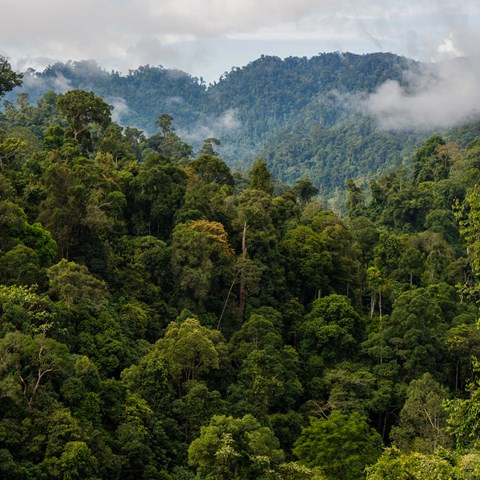Contact
Department of Forest Ecology and Management, Department of Forest Ecology and Management, joint staff

Since 1998, we have been working with our partners to restore degraded rainforest, using scientific methods to evaluate different approaches and build knowledge about how best to restore degraded rainforest for different types of objectives. We want our knowledge to be used. Here are some of the key lessons we have learned so far.
The Sow-A-Seed project in Sabah, Borneo, was launched in 1998 to rehabilitate 18,500 hectares of tropical rainforest degraded by logging and later by fire during the 1982-1983 El Niño. Sabah Foundation and IKEA built the project from the ground, including basic infrastructure, roads, nurseries, and housing for employees and family, and last but not least, developing knowledge.
In the project, three restoration techniques were used depending on the level of degradation:
The level of degradation was the basis for the choice of restoration strategy.
Click for enlarged image.
While the forest structure in the restoration area has not yet reached the complete biomass and structure of undisturbed rainforest, the combination of protection, enrichment planting and assisted natural regeneration has helped the forest to develop faster than would have been possible without the project.
Camera-trapping and sound recordings indicate that the general species composition is similar to nearby protected forests. We observe different wildlife, including orang-utans, banteng, sunbear, and all of the wild cats of Borneo.
The area, that otherwise would have been converted to oil palm plantation, has been re-classified to class-one forest, which is the highest protection status in Malaysia and can be a valuable resource for wildlife protection, eco-tourism and research.
To maximize the biodiversity outcome, the project planted more than 85 native tree species. Most species were then planted without any available silvicultural or ecological information.
In species trails we have found that the different tree species vary manifold in performance (germination, growth and survival), financial value and contribution to biodiversity.
We could now use this information to adjust how the number of planted seedlings are distributed across species, depending on the restoration goal (maximizing biodiversity, carbon, sequestration, financial return, or a combination of different restoration goals).
After 20 years, the average height of most planted species ranges between 5 to 20 m, and average mortality across species is leveling off. The survival indicates that planting 300-400 seedlings per ha is appropriate to eventually achieve a stem density of large trees (ca 25 trees per ha >60 cm dbh) comparable with a pristine forest.
However, the seedling density and species composition will affect the result and could be adjusted depending on the restoration goal (see points 2 and 4). We also see that at the plot level, planted trees increase the tree species richness of the restored forest and more so in more disturbed forests were planted plots had about 35% higher dipterocarp richness.
After 15-25 years, some species have reached a reproductive size and are contributing to new stand regeneration. When forests are least disturbed - with enough overstory trees left after logging and fire - the forest can develop positively with assisted natural regeneration only.
Our observations show that even with enrichment in the moderately disturbed forest, the associated 10-year period of assisted natural regeneration gives the highest benefit during the first 20 years.
Still, we believe that the benefit of enrichment will increase as more of the planted trees reach the canopy of pioneer trees. The level of disturbance that justifies enrichment planting over assisted natural regeneration in the long term is currently unknown. This would be one of the most important issues we could address with continued research in the project.
We have also found that the different tree species vary in their contribution to broader biodiversity. In a case study with beetles (coleopteran) we found that beetle richness in the canopy of planted trees varied threefold, and that it would take at least 48 different tree species to cover most of the beetle diversity associated with these trees.
Species traits are essential, e.g., selecting the fasted growing species will decrease the related diversity.
In addition to the among-species variation, within-species (genetic) variations can be used to enhance the outcome of enrichment planting. The choice of mother trees alone might affect the initial height growth 2-3 fold, but more long-term research is needed.
For now, we suggest that operation restoration maximize genetic variation by seed sourcing from different populations and mother trees. For future development, we have started collecting genetic material in “common garden” experiments, which can also serve as a biobank of rare genetic material for future restoration needs.
Due to the irregular mast fruitings, these are unique for the mixed dipterocarp rainforest and is a valuable resource for the future use of native tree species in the region. We recommend expanding such common gardens to include other important and rare native species.